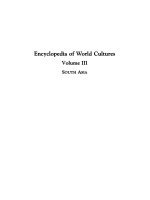Encyclopedia of World Cultures Volume III - South Asia - C ppt

Encyclopedia of World Cultures Volume III - South Asia - C ppt
... is not thought manageable to have to walk more than 12 kilometers or so to one's fields, so that a village's territory extends not much above 10 kilometers from the settlement periphery. An average household can and must cultivate a field of 2 hectares or so. Traditionally, when the population of a village outgrew its effective ability to get access to farm tracts it would move...
Ngày tải lên: 02/07/2014, 20:20

Encyclopedia of World Cultures Volume III - South Asia - I ppt
... Indian priests, and also brought in large numbers of European Jesuits in a su- pervisory capacity. The year 1947 marked a landmark in Protestant church history, not just because this was the year of independence for both India and Pakistan but also because it was the year when the Church of South India came into being-the first unified Protestant church anywhere. It of course absorb...
Ngày tải lên: 02/07/2014, 20:20

Encyclopedia of World Cultures Volume III - South Asia - L pptx
... care for jhum fields and girls are taught how to weave. Magicoreligious rites are, for the most part, mastered by means of observation. The sole exception to this norm is the Khazangpina chant (which ac- Limbu 149 or Nepali dishes. Rice is the most popular staple of the Lepcha diet; wheat, maize, and buckwheat are also eaten but are not nearly as popular. Millet is grown for fermenting as...
Ngày tải lên: 02/07/2014, 20:20

Encyclopedia of World Cultures Volume III - South Asia - T ppt
... in Thakhola, which began even before the 1960s, is summarized as follows. (1) Changes in the Thakali way of life have been instituted, such as avoid- ance of eating yak meat (beef) and of drinking Tibetan beer. (2) Some of the Thakali leaders have discouraged the mem- bers of the community from wearing bakus (Tibetan robes) and have encouraged them to wear Nepalese or Western dress...
Ngày tải lên: 02/07/2014, 20:20

Encyclopedia of World Cultures Volume III - South Asia - Appendix ppt
... northern and central India, numbering several millions. Their traditional occupation was tapping palms for the sap, but they also used to be thieves. Now some are hunters and fowlers; most are farmers. (Risley 1891, 2:16 6-1 68; Crooke 1896, 4:13 8-1 52; Thurston and Rangachari 1909, 6:15 8-1 59; Rose 1911, 2:204; Russell and Hira Lal 1916, 4:38 0-3 85) Patari (Pathari) A caste of p...
Ngày tải lên: 02/07/2014, 20:20

Encyclopedia of World Cultures Volume III - South Asia - Overview pot
... South Asia. " In Anthropological Bibliogra- phies: A Selected Guide, edited by Margo L. Smith and Yvonne M. Damien, 10 6-1 21. South Salem, N.Y.: Redgrave Publishing. Dumont, Louis (1970). Homo Hierarchicus: An Essay on the Caste System. Translated by Mark Saintsbury. Chicago: Uni- versity of Chicago Press. Garrett, John (187 1-1 873). A Classical Dictionary of India Il- lus...
Ngày tải lên: 02/07/2014, 20:20

Encyclopedia of World Cultures Volume III - South Asia - A doc
... the various Abor groups) and external (i.e., with neighboring peoples) warfare were effectively elimi- nated after the initiation of British rule. Conflict between vil- lages is handled by the bango council and the resolution of interbango conflict is the responsibility of the bogum bokang. Religion and Expressive Culture Religious Belief&. Abor religion is characterized by a belief...
Ngày tải lên: 02/07/2014, 20:20

Encyclopedia of World Cultures Volume III - South Asia - B potx
... the sur- rounding slopes. The closest ties are with the seven nearby Kota villages. Until 1930 every Badaga family had a Kota as- sociate who provided a band of musicians whenever there was a wedding or funeral in that family and who regularly fur- nished the Badagas with pottery, carpentry, thatching, and most leather and metal items. In return for being jacks -of- all- trades to the Badag...
Ngày tải lên: 02/07/2014, 20:20

Encyclopedia of World Cultures Volume III - South Asia - D,E,F doc
... old culture is comprised of three main layers: the Tamil-Malayalam substratum with its many subtle roots; old Sinhala culture and language, which is the dominant element; and the phase of Arabic in- fluence. But the Maldives were touched by every cultural wind that passed over the Indian Ocean. Since independence there has again been influence from Sri Lanka, through its teachers brought...
Ngày tải lên: 02/07/2014, 20:20

Encyclopedia of World Cultures Volume III - South Asia - G pot
... her deceased husband. Socialization. The ambition of every Gond woman is to bear a son. Barrenness in a woman is considered a curse. Preg- nancy and birth are surrounded with protective rites against magic spells and evil influences. Children are generally wel- come and treated with affection. Although sons are preferred, daughters are welcome too. Children grow up without much restriction,...
Ngày tải lên: 02/07/2014, 20:20